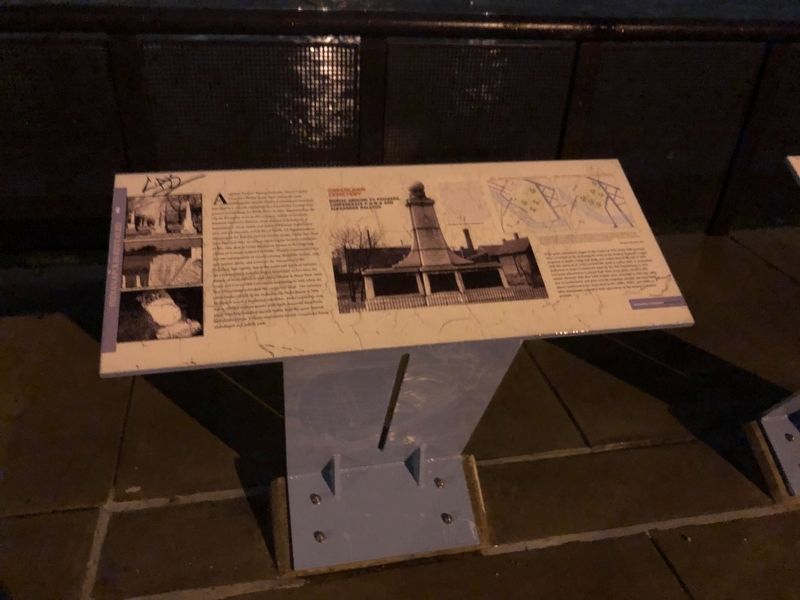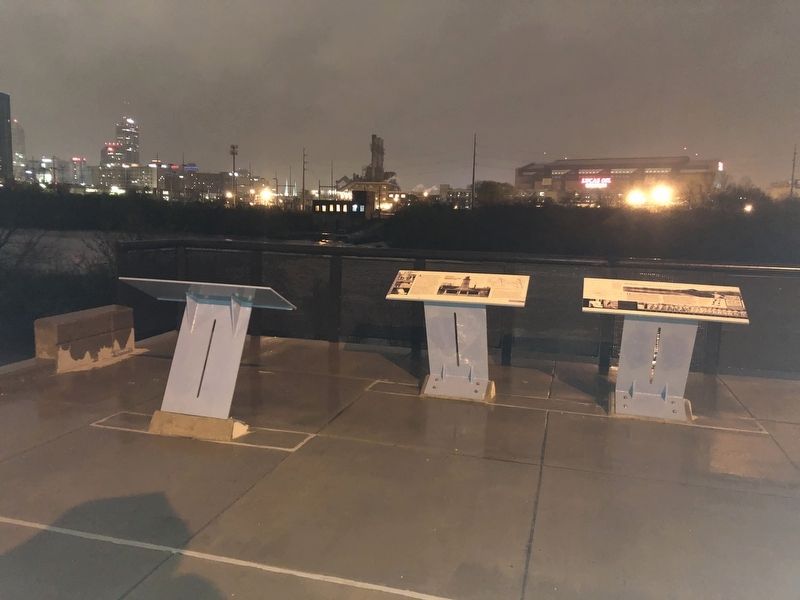West Indianapolis in Marion County, Indiana — The American Midwest (Great Lakes)
Greenlawn Cemetery
Burial Ground to Pioneers, Confederate P.O.W.s and Alexander Ralston
— Indianapolis Revealed —
Aegidius Nactner, Hanna Hornaday, Daniel Crosby Lane, and Phillip Kraus were among the early Indianapolis citizens buried at Greenlawn Cemetery founded by a citizens committee on a beautifully wooded high ground overlooking the White River in 1822. Reached from the city by Kentucky Avenue the cemetery and its monuments honored Alexander Ralston, town planner and designer of Indianapolis, Noah Noble and James Whitcomb, both Governors and US Senators, Caleb Blood Smith, US Representative, Secretary of the Interior and US District Judge, Union war dead from the Civil War, as well as receiving for burial Confederate POWs who died at Camp Morton of disease or the lingering effects of wounds suffered in battle. Caught between the river and the rapid growth of manufacturing, slaughter houses, coal and lumber yards, and railroads the tranquility of the Cemetery was rapidly lost to the noise and odors of industry. As a consequence families began to exhume and re-bury the bodies of early pioneers, and other citizens to floral Park, Holy Cross and Crown Hill Cemeteries beginning in 1866 when the War Department relocated 700 union war dead. The cemetery came under control of the Indianapolis Parks Board in 1896. By then it was in a neglected condition. Parks erected an iron fence, refilled sunken graves with earth, removed dead trees, place benches, installed electric lights, kept the grass mowed and planted trees. Citizen resentment lead to Greenlawn being abandoned as a public park.
Mass grave relocations began in the winter of 1912 when 1100 pioneers were re-buried as the Indianapolis team of the Federal Baseball League prepared to build a large ball park, and ended later in the fall of 1931 with the removal of 1,616 Confederate dead to Crown Hill. A monument dedicated to those Confederate dead by the War Department in 1912 had been relocated to Garfield Park three years prior, where it still stands. Records state that 2,035 burials were relocated in 1924, but sadly due to carelessness and poor records forgotten citizens and their head stones continued to be uncovered in the 1940's, 1960's, and 1980's as other businesses expanded their operations in the former Cemetery grounds.
"…at 9:45 the graves of the men who wore the gray were not forgotten. Frank Riley, a bright young attorney, spoke of their valor. "There are those who think it surprising that such tender regard and high respect should be shown to these confederate dead by the men who fought and conquered them so many years ago. To me it seems only natural and fitting. It could not have occurred to us to cover these graves with flowers on a day sacred to the Grand Army of the Republic, unless we respected the tender memoriesthat have an ever abiding place in our hearts of the soldiers who wore gray. So with cheers for the living and means for the dead, the prophecy of Abe Lincoln has been fulfilled. We are not enemies, but friends. Though passion may have been strained, it must not break our bonds of affection. The mystic chords of memory, stretching from every battlefield and patriotic grave to living heart and hearthstone all over this broad land, will yet well the chorus of the union."
Thursday 30 May 1912 The Indianapolis Sun
Topics. This historical marker is listed in these topic lists: Cemeteries & Burial Sites • Parks & Recreational Areas • Settlements & Settlers • War, US Civil. A significant historical year for this entry is 1822.
Location. 39° 45.708′ N, 86° 10.505′ W. Marker is in Indianapolis, Indiana, in Marion County. It is in West Indianapolis. Marker is on South White River Parkway West Drive south of West Washington Street, on the right when traveling north. Touch for map. Marker is in this post office area: Indianapolis IN 46221, United States of America. Touch for directions.
Other nearby markers. At least 8 other markers are within walking distance of this marker. Federal Field (here, next to this marker); Manufacturing for Transportation (a few steps from this marker); The Pumphouse (approx. 0.4 miles away); a different marker also named The Pumphouse (approx. 0.4 miles away); McCormick Cabin Site (approx. 0.4 miles away); Washington Park Baseball (approx. half a mile away); Politicians, Poets, and Lion Tamers (approx. half a mile away); National Road Legacy Project (approx. half a mile away). Touch for a list and map of all markers in Indianapolis.
Credits. This page was last revised on March 13, 2023. It was originally submitted on April 26, 2019, by Devry Becker Jones of Washington, District of Columbia. This page has been viewed 363 times since then and 24 times this year. Photos: 1, 2. submitted on April 26, 2019, by Devry Becker Jones of Washington, District of Columbia.
Editor’s want-list for this marker. Clear, daylight photo of the marker • Clear, daylight context photo of the marker • Can you help?

